Foster kids get secret admirer’s gift
July 6, 2011
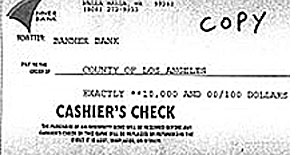 In an act of generosity so surprising that it generated national headlines, a mystery donor last month gave $10,000 to Los Angeles County, asking only that it be put to “good use.” This week, the Board of Supervisors did just that, voting to use the money for the benefit of the county’s foster children.
In an act of generosity so surprising that it generated national headlines, a mystery donor last month gave $10,000 to Los Angeles County, asking only that it be put to “good use.” This week, the Board of Supervisors did just that, voting to use the money for the benefit of the county’s foster children.
The cashier’s check, dated May 2 and drawn on a bank in Bellingham, Wash., was mailed directly to the county Auditor-Controller’s Office with a handwritten note that said: “In this time of economic difficulties, governments need all the help they can get. Please put this anonymous check to good use. God Bless.”
But the donor didn’t name a specific department for the gift, meaning that the money was headed for the county’s multi-billion dollar general fund, a fate that somehow seemed too unceremonious for the grandness of the gesture.
So Supervisors Zev Yaroslavsky and Michael D. Antonovich introduced a motion directing that the money be deposited with the Children’s Trust Fund, a non-profit organization that provides direct aid to foster children. The motion was unanimously adopted.
Operating under the auspices of the county’s Department of Children and Family Services, the organization was founded in 1968 by a group of social workers to take up the slack for services not funded by the government. According to its website, the Children’s Trust Fund last year served 5,000 foster youth by paying for, among other things, clothing, educational field trips, sports equipment, replacement glasses and dental work not covered by insurance or Medi-Cal benefits.
“This donation is going to have a positive impact on so many lives,” said DCFS’ public affairs chief, Nishith Bhatt, who added that, because Children’s Trust Fund has no administrative overhead, 100 percent of its donations go directly to services for foster children. “It’s really a unique thing.”
Meanwhile, during Tuesday’s Board of Supervisors meeting, one member of the public offered his personal appreciation for the donor’s contribution. And that led to an intriguing exchange with Supervisor Antonovich.
“I just want to say, whoever that donor is, well, thank you on behalf of all of us residents in L.A. County,” the speaker said during a period for public comment.
“He’s a very charitable person who one time served as a public official in this county,” Antonovich responded.
Surprised, the speaker asked: “So we do know who he is?”
“Yes, I know who he is,” the supervisor said. “But if he wanted you to know who he was, he would have told you.”
And with that, the board moved on to its next order of business.
Posted 7/6/11
Celebrate the USA the Third District way
June 30, 2011
Budget concerns may have forced L.A. County’s Department of Beaches and Harbors to scrap their annual fireworks display in Marina Del Rey, but that doesn’t mean you’re out of luck this Fourth of July. Plenty of pyrotechnical celebrations will be shimmering throughout the county. Here are some of the festivities planned in the Third District:
Studio City
For one day, the fireworks will outshine the stars in Studio City, as it celebrates the 4th with “Let Freedom Ring,” a music, food and fireworks festival at CBS Studios.
A 70’s disco cover band and comedy act, Boogie Knights, headlines the night’s entertainment. There will also be a car show from the Television Motion Picture Car Club, a model airplane show, dancers and a hand bell choir. You can dine on the BBQ sold there or bring your own food.
The event takes place at CBS Studio Center, 4024 Radford Avenue, on July 4 from 5 p.m. to 9 p.m. Tickets are $20 for adults, $10 for kids ages 6 to 12, and free for kids 5 and under. VIP tickets are also available and include an assortment of additional luxuries like a gourmet dinner on an air-conditioned soundstage and rooftop fireworks viewing.
All tickets include free parking and may be purchased online, by calling (818) 655-5916, or in person at the Studio City Farmer’s Market this Sunday from 8 a.m. to 1 p.m.
Hollywood
Darryl Hall & John Oates and the Hollywood Bowl Orchestra will provide a musical backdrop for the Hollywood Bowl’s annual fireworks gala. Hall & Oates’ rock and pop songs were virtually unavoidable if you turned on the radio in the late 70s and early-to-mid 80s. “Rich Girl” and “Maneater” are just two of their five No. 1 Billboard Top 40 hits. If that’s not enough to satisfy your inner patriot, the Bowl Orchestra will play old-fashioned American classics.
Tickets start at $12 and may be purchased online from Ticketmaster or by calling (323) 850-2000. Details on getting to the Bowl are available on its website. Parking starts at $15 and is limited, so you may want to take advantage of the park-and-ride.
Santa Monica
Santa Monica’s annual parade is themed “4th of July at the Beach” to honor the L.A. County Fire Department Lifeguards who keep it safe.
Local groups will float and march down Main Street from the Santa Monica Civic Center to the border of Venice. The parade is sponsored by the California Heritage Museum and Ocean Park Association. Afterward, the celebration continues at Heritage Square with live music and dancing, food trucks and a picnic on the lawn. It all starts at 9:30 a.m., so there will be plenty of time for other revelry later in the day.
Pacific Palisades
The Pacific Palisades 4th of July parade goes back 63 years and has been led by such notables as Chevy Chase and Martin Short. This year’s grand marshal is actor Jeffrey Tambor. Honorary Mayor Sugar Ray Leonard joins him to preside over the parade. One Palisadian, Sarah Kelley, has so many fond memories of this event and its characters that she is filming it for a documentary.
Skydivers start the fun at 1:50 p.m. and the parade gets moving at 2 p.m. More than a thousand marchers will take the streets. Parade route and details are available online.
After the parade, at 6 p.m., a concert and fireworks display will commence at Palisades Charter High School. Reggae artists Rocky Duwani and Band headline the music menu, and the fireworks start at 9 p.m. Admission is $2, with proceeds going to the Palisades Charter H.S. Music Department.
Woodland Hills
Not to be outdone, Woodland Hills boasts the biggest fireworks display in the valley, and claims the highest attendance, too–50,000.
Dennis P. Zine’s July 4th Extravaganza will have a 20 minute fireworks display and live patriotic music from Los Angeles Pierce Symphonic Winds and others. Twenty local restaurants will be on hand.
The event, produced by Valley Cultural Center and sponsored by L.A. City Councilmember Zine, begins at 6 p.m. July 4 (the fireworks are at 9:05). It takes place in Warner Park and is free to the public.
Sunland-Tujunga
Sunland-Tujunga’s celebration is full of summer fun for families. Starting at 4 p.m., there will be a hula hoop contest, water slides, moon bounces, water balloon fights, live music and plenty of food. Fireworks start at 7 p.m.
The event is sponsored by the Sunland-Tujunga Neighborhood Council, and it takes place at Verdugo Hills High School, 10625 Plainview Avenue on July 4. Entry is $5.
Calabasas
Calabasas has a little something for everyone this Independence Day, beginning at the Calabasas Tennis & Swim Center, 23400 Park Sorrento.
Get a healthy start with the Lakeside Fun Run at 7:45 a.m. Choose a 4-mile run, 2-mile run or 2-mile walk. Kids can participate in a ¼-mile race. At 10:30 a.m., a pet show will be held for all your furry and scaly friends. Don’t worry if your mutt or hound (or even your lizard) is not up to pedigree–all pets are welcome. Sign up for the run or pet show by calling (818) 222-2784.
If you’re feeling the heat after your run, cool off at the Summer Splash Party from 11 a.m. to 5:30 p.m. There will be swimming, water games, tennis, barbecue, dancing and a DJ.
Finally, head over to Calabasas High School for the City of Calabasas’ annual 4th of July Fireworks Spectacular. Starting at 5 p.m. you can enjoy live soul and Motown tunes, rides, crafts, balloon artists and games for the family–all followed by the fireworks at 9 p.m. Tickets must be purchased in advance from City Hall, the Tennis & Swim Center, or Juan Bautista De Anza Park for $11 (kids under 2 are free).
Malibu
Like your fireworks served over the largest body of water on the planet? Consider heading to Malibu, where you can see the sun set over the Pacific before explosions light the night sky. While Malibu has no official fireworks display, they permit some private displays. This year there are four of them:
- 9:00 pm – launch from barge offshore of Malibu Colony
- 9:00 pm – launch from barge offshore of 21500 block of PCH
- 9:00 pm – launch from barge offshore of 22300 block of PCH
- 9:00 pm – launch from barge offshore of 27900 block of PCH
Posted 6/30
The patron saint of…government?
June 16, 2011
Los Angeles County’s top auditor, Wendy Watanabe, thought it had to be a joke or a scheme. At a time when government has come under the public lash, who would mail a $10,000 cashier’s check to the County of Los Angeles—especially someone in Washington State?
And who, in an accompanying note, would write something like this?: “In this time of economic difficulties, governments need all the help they can get. Please put this anonymous check to good use. God bless you.”
Given such unusual circumstances, Watanabe and her staff figured that the check might be counterfeit; the office has had some experience with that kind of thing in the past. But then, remarkably, it cleared the bank.
“We were elated that there would be such a good person out there,” said Watanabe. “Most of the time we get attacked for overspending. For someone to actually donate to the government, it’s just unheard of.”
“Why this person picked L.A. County, we have not a clue,” she added. “Maybe they’ve sent $10,000 to every government agency out there.”
For now, because of bank confidentiality rules, there’s no way to know much beyond the basics. The check was mailed directly to the Auditor-Controller’s Office. It was purchased at Banner Bank on May 2 and lists a toll free number in Walla Walla, Wash. A bank representative, contacted by a writer for Supervisor Yaroslavsky’s website, would reveal only that the transaction occurred at a branch in the town of Bellingham, about 90 miles north of Seattle. The branch employee who issued the check did not return several phone calls.
Every year, the county receives thousands of dollars in donations of various sorts, some of which are bequeathed in wills. For the most part, however, the recipients are specified, Watanabe says, with the lion’s share of money going to departments that deal with young people, such as children’s services and probation.
“Very rarely,” she says, “do we get a donation to a bunch of accountants and auditors. It’s a good feeling that they trust us.”
Unless the Board of Supervisors directs otherwise, Watanabe says, the money will be deposited in the county’s general fund.
Posted 6/16/11
Voyage to the center of the Earth Day
April 21, 2011
This weekend, you may hear the rumble and hoot of a distant drum circle inviting you to Topanga Earth Day.
Heed the call and you’ll find yourself transported to Los Angeles County’s Earth Day epicenter as Topanga Canyon lives up to its nature-centric reputation and throws a planet-loving bash to remember.
Where else on the planet, after all, can you spend a weekend building a tipi, making a seed ball, dropping by a Healing Arts Tent, listening to the Grateful Dead’s drummer and sipping some locally-produced wine—all in a one-of-a-kind community that’s just miles from Hollywood and the Westside on the map but a galaxy away in spirit?
Topanga’s annual holiday celebration began in 2000, as locals celebrated after a volunteer cleanup of Topanga Creek. Now the full-fledged festival lasts all weekend and includes musical acts from across the globe. The creek is so pristine that it doesn’t need cleaning this year, so the volunteers have shifted their focus to local beaches instead.
 Many Topangans view themselves as stewards of the land, dutifully repaying the earth for the magic and majesty it bestows upon them in the form of fabled creeks and craggy mountains. Darkened by the canyon and a dearth of streetlights, it’s one of the rare places close to the city where you can still clearly see the night stars.
Many Topangans view themselves as stewards of the land, dutifully repaying the earth for the magic and majesty it bestows upon them in the form of fabled creeks and craggy mountains. Darkened by the canyon and a dearth of streetlights, it’s one of the rare places close to the city where you can still clearly see the night stars.
“We are surrounded by 200 square miles of state park,” notes Stephanie Lallouz, organizer of Topanga Earth Day. “Because of that, most of us in the community are pretty in tune with nature. We drive slower to protect the coyotes and bobcats.”
A bohemian spirit and ‘60s ethos lingers on in a place where folks like Joni Mitchell, Jim Morrison, Neil Young, and Marvin Gaye once lived, played or made music. And Earth Day 2011 seems a fine time to discover what they—and Topanga’s current eclectic crop of residents—have long known about this particular place in the sun.
The celebration begins Friday, April 22 from 7-10 p.m. with an eco-art show opening, wine tasting, and jazz. The main event is Saturday and Sunday, and it lasts from 10 a.m. to sunset both days. There will be music, speakers, workshops, a children’s activity area, and plenty more.
Organizers take pride in the multicultural nature of the jubilee, so you can expect to find many parts of the planet represented. Musical acts hail from places like Africa, Florida, Japan, Jamaica, Israel, Jordan and India, to name a few. (Bill Kreutzman, original drummer for Grateful Dead, is also expected to make an appearance.)
Planned festivities are educational (learn to “plant native,” compost, and use earth-friendly technology), entertaining (a band that uses a 30-foot string setup, belly dancers, and wine tasting), service-oriented (beach clean-up, tree planting), creative (recycled art, flag painting), and esoteric (chanting, reiki).
You can make seed balls and learn ways to conserve water. You also can practice yoga in the morning, have an organic vegetarian lunch, and participate in a sacred Japanese tea ceremony. Along the way, learn to build a tipi and participate in a guided philosophical discussion inside of it.
For a full rundown of activities, visit the Topanga Earth Day website.
For entry, there’s a $12 suggested donation. Eco-friendly non-profit organizations will receive 60% of the proceeds, with the remaining 40% going towards next year’s event. This year’s beneficiaries include Doctors Without Borders, Sea Shepherd and the Topanga Community Club.
The event is sponsored by diverse community, government, and business groups, who will host booths with their own offerings. L.A. County Department of Public Works’ Waterworks program will be on hand with free giveaways as they educate the public on methods of water conservation.
If you go, keep the health of the planet in mind. Rideshare to designated parking locations along Topanga Canyon Boulevard, then bike, hike, or take the free BioDiesel Shuttle up to the festival at the Topanga Community Club Fair Grounds, 1440 N. Topanga Blvd., Topanga, CA 90290.
Posted 4/21/11
Trailblazer makes his mark in Calabasas
March 31, 2011
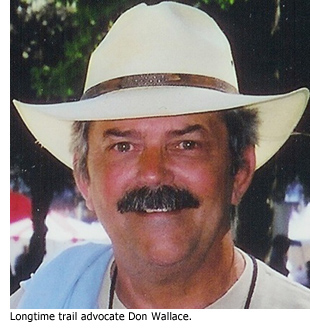 March was a banner month for Don Wallace. And not just because he and his wife, Jeanne, celebrated their 50th wedding anniversary.
March was a banner month for Don Wallace. And not just because he and his wife, Jeanne, celebrated their 50th wedding anniversary.
“We finished the party,” Wallace remembers, “and the very next afternoon, the phone rang.” With friends and family still filtering in and out of the Wallaces’ 4.5-acre ranchette in the Santa Monica Mountains, the longtime trail advocate let out a whoop as he received news for which he had waited most of his 70-year lifetime:
His beloved Las Virgenes Creek Trail had finally found its way under the Ventura Freeway.
“I was ecstatic,” Wallace says, still thrilled at the approval earlier this month of $300,000 in excess county bond funds that will allow the trail to run uninterrupted from the Santa Monica Mountains down through underpasses at the 101 and Agoura Road in Calabasas and on into Malibu Creek State Park.
The trail easement and improvements—officially dubbed “The Don Wallace Trail Project”—will not only connect the Santa Monica Mountains to the beach for people, horses and wildlife, but also honor one of the most zealous and hardworking trail advocates in Southern California.
For decades, Wallace and other activists have sought to create a path that would allow people and animals to follow Las Virgenes Creek from the pristine mountains down to the ocean, but their dream was stymied by development and traffic. Even as crucial tracts were acquired for the public, the 101 Freeway remained a dangerous concrete barrier between the mountain part of the trail and the beach part.
Then, last year, with funding allocated by Supervisor Zev Yaroslavsky, the Mountains Recreation and Conservation Authority bought a key swath of wilderness known as Firehouse Hill from the developer Fred Sands. The nearly 200-acre Calabasas property is a gateway to the Santa Monica Mountains National Recreation Area—and sits right next to the freeway.
Though environmentalists, activists and government officials cheered the acquisition for many reasons, trail advocates immediately saw its potential as an avenue through which they could bring the Las Virgenes Creek Trail—which is part of a larger loop called the Calabasas Cold Creek Trail—down to and under the 101 along a flood control easement, where it could then connect to the Malibu Creek State Park trail system. They’d just need to make the underpass safe and accessible.
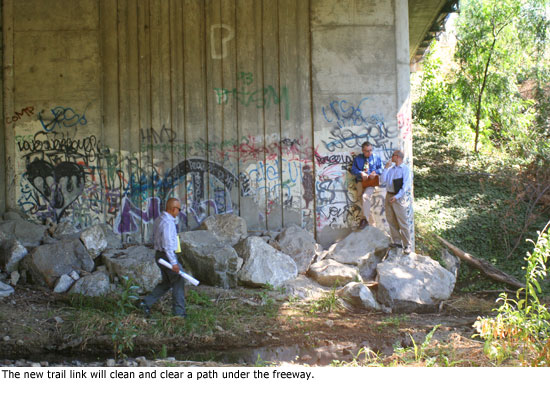
The March vote provided that crucial support, opening the way for a 2,500-foot link that is expected to break ground next year.
“This is a wonderful victory,” said Wallace, crediting the many public agencies that pushed for the project. But Wallace’s friends and fellow advocates say there’s a reason the key link is being named after him.
“He’s one of the hardest working gentlemen I know,” says Stephanie Abronson, who edits the newsletter for Equestrian Trails Inc., Corral 36, a mountain equestrian group.
Born in Tennessee , Wallace moved to Van Nuys as a teenager after his father, a restaurant owner, visited relatives here and made it a goal to move to California . At 20, he married Jeanne, whom he’d met in a chemistry lab at Pierce College .
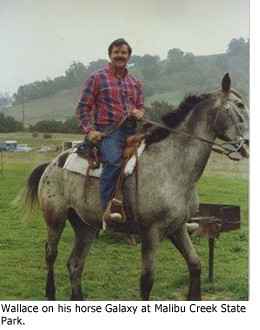 The couple settled in Canoga Park , had two sons and got into horseback riding, eventually deciding that they wanted enough land to have their own corral. Wallace, by now a Los Angeles city firefighter, found a spread near the unincorporated community of Monte Nido, and the couple built a house on it. They still live there with assorted horses, cats and dogs and a potbellied pig.
The couple settled in Canoga Park , had two sons and got into horseback riding, eventually deciding that they wanted enough land to have their own corral. Wallace, by now a Los Angeles city firefighter, found a spread near the unincorporated community of Monte Nido, and the couple built a house on it. They still live there with assorted horses, cats and dogs and a potbellied pig.
A trail ran near the Wallace’s acreage, and one day in the early 1970s, he says, a neighbor who wanted to build a winery came out with a bulldozer and blocked it in an attempt to keep passersby away.
“That trail had been put in in 1935 by the Boy Scouts,” says Wallace, who eventually forced the neighbor to open an alternative easement.
“It took three years of work and masses of paper, but I learned never to give up and never to say that it can’t be done.”
Since then, Wallace has served on the Santa Monica National Recreation Area Advisory Commission, the Resources Conservation District of the Santa Monica Mountains, the Malibu Creek Watershed Council and many other groups seeking to improve the mountains community.
He also served as a deputy for then-Supervisor Edmund D. Edelman in the early 1990s, and ran for supervisor himself in 1988 and 1994.
Throughout, when he wasn’t lobbying for trails or riding his horses on them, he was out clearing them with his bare hands, says Ruth Gerson, president of the Santa Monica Mountains Trail Council—“repairing tread, cutting back brush, reducing erosion, and encouraging others to work with him.”
That commitment has been challenged in recent years by health problems. Wallace says he has faced a stroke, vascular surgery and two bouts of prostate cancer since the 1990s; last year he underwent a triple bypass.
But his projects are far from finished—he’s already wondering how to restore the old Boy Scout trail behind his house.
“I walk every day,” says the trail blazer. “And I’m a very strong guy for 70.”
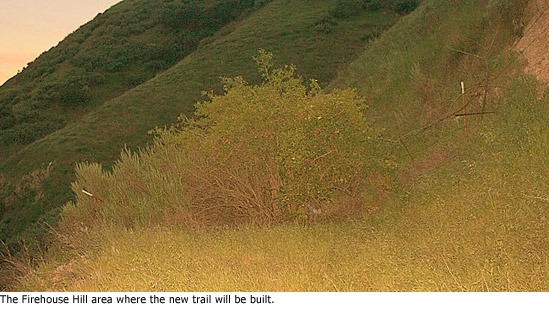
Posted 3/31/11
Beach’s elder statesman looks back
March 10, 2011
 Edward Craig remembers waves so oil-polluted that he couldn’t swim without washing himself afterward with turpentine. He remembers beach crowds so environmentally careless that they blithely dumped their trash right onto the sand.
Edward Craig remembers waves so oil-polluted that he couldn’t swim without washing himself afterward with turpentine. He remembers beach crowds so environmentally careless that they blithely dumped their trash right onto the sand.
He remembers when surfers waxed their longboards with the paraffin their mothers used for canning. He remembers when women’s tank suits turned to bikinis and bikinis turned to thongs.
But ask the 70-year-old how many lives he has saved as Los Angeles County’s longest continuously serving lifeguard, and memory fails him. “Oh, my gosh,” he says. “Thousands.” Which makes sense, since Craig has been watching over local beach-goers every summer, without exception, for more than 50 years.
A retired teacher who for 38 years taught music in the Anaheim Union High School District, and who still supervises student teachers at Biola University, Craig has had a second career lifeguarding on weekends and summers since his late teens. County employment records show he was hired in May 1959 and has worked every summer since, including last summer. (One other recurrent lifeguard is older and has an earlier hire date, but records indicate that a medical issue sidelined him last year.)
“I’ve always liked the water,” says Craig, who grew up in Lennox and bicycled as a child down Imperial Boulevard to the ocean. “Riding on the waves as a body surfer, the ocean throwing you toward shore.”
Craig played water polo at Inglewood High School, El Camino College and Cal State Long Beach, and spent his childhood swimming and surfing in the South Bay. His favorite beach as a young man, he says, was the popular Manhattan Beach surf hangout known as El Porto; located near the Chevron oil refinery in El Segundo, its signature attraction is underwater—a deep fissure in the bay floor known as Redondo Canyon, which generates bigger-than-average waves on a consistent basis.
It also generates bigger-than-average crowds and bigger-than-average risks for swimmers—downsides that Craig would learn more about when, at 19, he became an ocean lifeguard. El Porto, which is still where he works most, ended up being his first professional post.
“On my first day on the job, I had 37 rescues,” Craig remembers. “People losing their boards, people stepping into rips. It was a pretty rough day.”
Does he remember the first swimmer he saved? “No,” he says, “but I do remember some amazing rescues over the years.”
There were the two exhausted swimmers he pushed for the length of three football fields on a surfboard to free them from a particularly vicious riptide.
There were the seven kids from Lawndale who ran full-tilt into the ocean, even though they could not swim and Craig had warned them to stay out of the water.
“I had two on the can, one by the hair, one in a cross-chest carry, one holding onto my foot, ” he remembers. “I was out there by myself—all the other guards were involved in other calls that day. Fortunately an older surfer came by and took the other two off my hands.”
Then there was the yellow Labrador who chased a stick into a riptide, leaving his anguished master ankle-deep in water, shouting the dog’s name helplessly at the waves. “The dog was way out there and really struggling—I could just see his nose barely sticking out of the ocean,” Craig remembers.
“I started swimming, wondering how in the world I was going to do this rescue. But when I swam up and I shoved my rescue can under his belly, he put his paws through the front handholds and they got stuck! I was able to drag him to shore, and the guy was so grateful, he came back to the tower with a case of beer the next day.”
Craig was glad, too: “I kept thinking, ‘What if I have to give this dog mouth-to-mouth?’”
Craig says the county’s beaches have changed substantially over the summers. For one thing, they are much cleaner and safer than they used to be.
“There was a lot more pollution. We’d often take a gallon of turpentine along to wash ourselves off after swimming. We’d paint each other down with a big paintbrush—you didn’t want to track that oil through your mom’s house. Also there was a lot of litter—you could look all up and down the beach and not see a trash can. And there was a lot more tar on the beach.”
Now, government regulation and environmental consciousness deter litterbugs and industrial polluters. “The beaches are meticulously cleaned,” Craig says. “We have four trash cans every hundred yards.”
And beach-goers are safer. Lifeguards are more professional, more numerous, better trained and stationed in lifeguard towers that are better equipped and closer together.
“Back in the ’60s, rescues were much longer distance because people would be pulled out farther,” Craig remembers. “Not because ocean conditions were different, but because there were so many fewer of us that by the time we got to them, they could be 50 yards offshore in a big boil. And there were no wave runners to help us out.”
Nor, for many years, was there much law enforcement, at least at El Porto. When Craig started, the beach was an unincorporated “county island” between Manhattan Beach and El Segundo. Packed end-to-end with little surf shacks arrayed along narrow alleys, El Porto was notorious in those early days for the bevies of airline stewardesses who bunked there and the surfers who populated its raucous bar scene. Until Manhattan Beach annexed the 34-acre area in 1980, the nearest authorities were 20 minutes inland at the sheriff’s Lennox substation, he says.
“We had one period in the mid-1970s where a group of armed Nazi surfers declared it their turf,” Craig remembers. “They’d throw things at people from the parking lot and shoot holes into the back of the lifeguard towers.” If someone at the beach was injured, he says, the paramedics of first resort were the lifeguards. Now, of course, El Porto is just another well-patrolled coastal neighborhood in sedate, pricey Manhattan Beach.
One thing that hasn’t changed much is the exceptional fitness required of county ocean lifeguards. Craig still vividly remembers his first lifeguard certification test.
“You swam around a buoy at the Hermosa Pier, and then south to the breakwater, then around another buoy and then back to the beach,” he recalls. “You did this in mid-April, so the water was still quite cold. It was a thousand-yard swim, not counting the 200 yards out and the 200 yards back in, and there were over 200 people, probably, the year I took the test.
“They took the top 25 across the line. I saw the mob going for the buoy and I thought, ‘Oh, my God.’ I was a decent swimmer, but it was daunting. The water was so cold, and the current so strong, and the wind so fierce that almost half the people had to be picked up or brought back in before they covered the first 200 yards.”
But Craig made it: “I was No. 11,” he remembers. “These things stick in your mind. “
Craig still takes the test every year, and still passes. “Obviously I’m not the fastest guy on the beach, but my average time is about 10 minutes, 30 seconds, depending on conditions,” he says.
His fitness regimen is not the average 70-year-old man’s daily workout. A 30-mile bike ride every Monday. An 80-lap swim on Tuesday, Thursday and Saturday. Two-miles of wind sprints on the beach, twice weekly. A 3-to-5-mile row in a single-man Dory twice monthly. On-duty workouts daily. Oh, and he still surfs two or three times a month.
“He’s the perfect waterman—an elder statesman of lifeguarding,” says Section Chief Terry Yamamoto of the County Fire Department’s lifeguard division, who has known Craig for three decades, since Yamamoto was a teenager hanging out at El Porto and Craig was the summer lifeguard there. Craig, he says, was one of a handful of lifeguards who mentored him into the profession. Among other things, Yamamoto says, Craig taught him “how to stay calm in all situations.”
“The older you get, the wiser you get in this job,” says Yamamoto. “You can almost predict how people are going to behave on the beach. It becomes instinctual, so that you can be where you need to be almost before something happens.
“We’ve been on literally hundreds of rescues together, and because he’s been on the job for so long, Ed tends to be there as quickly as the younger guys because he knows where he’s going to be needed.”
Nonetheless, Craig says, “this year will probably be my last.”
“I’ve never lost a swimmer,” he says, “and I still feel I could make any rescue I could see. But I’m getting to the point now where you try to be realistic about your career.”
Retiring from the lifeguard tower would give him more time for his music, his wife of 46 years and his two granddaughters; it might also make for some slightly less stressful summers. “Ninety percent of the job is sheer boredom and ten percent is sheer terror,” jokes Craig.
Still, he says, “I don’t think I’ll ever get tired of watching the water—the pelicans flying by, the surf, the sailboats, the ships offloading their supplies. It never changes, and yet it’s always different, always moving. It’s one of the fascinating things about the sea.”

El Porto Lifeguard Station
Posted 2/16/11
Sowing the seeds of smart gardening
March 9, 2011
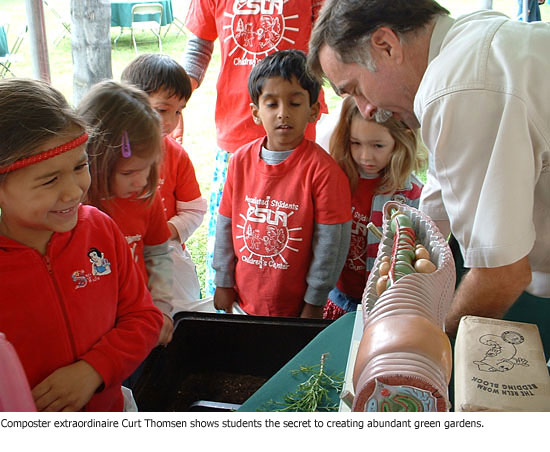 For a dozen years, Curtis Thomsen has crisscrossed Los Angeles County, preaching the gospel of gardening.
For a dozen years, Curtis Thomsen has crisscrossed Los Angeles County, preaching the gospel of gardening.
Don’t throw away yard waste, he exhorts. Composting can reduce water consumption by up to 50% per household. And don’t forget the lowly earthworm.
“Worm tea is the strongest organic fertilizer there is,” he likes to say.
Thomsen, an environmental consultant and master gardener based in Cerritos, has conducted the Countywide Smart Gardening initiative for the Los Angeles County Department of Public Works since 1998. Launched 20 years ago as a way to reduce the amount of yard waste being sent to landfills, the program has grown to encompass not only green-waste recycling, but a range of assistance on the creation and maintenance of sustainable landscapes.
The county now operates nine demonstration and learning centers where visitors can learn—for free—about sustainable agriculture, native plants, water conservation and organic gardening. As a bonus, Thomsen’s weekend workshops offer subsidized compost and worm bins for $40 and $65, respectively—a healthy 60% discount.
Countywide Smart Gardening information stands have been installed in parks, schools, community gardens and nature centers. The program’s experts will make presentations at the L.A. County Fair in September and host a booth at the Natural History Museum next month as part of its “Sustainable Sundays” program on “edible landscapes.”
Public Works’ Smart Gardening Program Manager David Perez says the program has educated thousands of Southern Californians, who have been increasingly driven toward home gardening by concerns about the environment and sustainability.
“We do free workshops where the public can learn about composting, where they can see native plants and native gardens, where they can get a feel for the process,” says Perez. And one of the most popular features (besides the discounted composting apparatus) is Thomsen’s no-cost advice.
“I come from an agricultural background—we’ve done composting since I was about 5,” says Thomsen, who was born in San Gabriel and raised on farms in Oregon and Idaho. Thomsen earned bachelors degrees at Oregon State in business administration and statistics, with a special emphasis in agriculture.
 He returned to Southern California in the early 1990s to get his certifications in solid and hazardous waste management at UCLA, just as municipalities were working to comply with a then-new law requiring cities and counties to halve the waste they were sending to landfills. Thomsen and his brother, Keith, who holds a Ph.D. from UCLA in environmental science, began working with engineering consultants to help local governments set up composting facilities and recycling programs before the law’s 2000 deadline.
He returned to Southern California in the early 1990s to get his certifications in solid and hazardous waste management at UCLA, just as municipalities were working to comply with a then-new law requiring cities and counties to halve the waste they were sending to landfills. Thomsen and his brother, Keith, who holds a Ph.D. from UCLA in environmental science, began working with engineering consultants to help local governments set up composting facilities and recycling programs before the law’s 2000 deadline.
That expertise, he says, led to the creation of their own environmental consulting firm, BioContractors, Inc., through which Thomsen—with contract oversight from Public Works’ Perez—now runs Countywide Smart Gardening. Thomsen and his crew do 50 workshops a year at the learning centers, plus another 35 or so hosted offsite presentations that are co-sponsored by church groups, nonprofits and other municipalities. Spring is crunch time; between Earth Day observations and demand for spring planting information, his calendar is typically booked solid.
“Right now we’re at 31 events scheduled for April alone,” he says.
“The big push we like to do is vermi-composting because it has so much benefit to the environment,” Thomsen says. That’s composting with worms. Thomsen’s favorites are Eisenia fetida (also known as African Red Worms or Red Wigglers). Bred to thrive in the debris layer of jungle topsoil, they can process massive amounts of organic matter quickly, eating and excreting 80% to 100% of their body weight each day in food waste.
Besides aerating the soil, Thomsen says, they produce manure, or castings, that can be mixed with potting soil to create a high-nitrogen bioactive fertilizer. And, he says, the liquid from those castings—a substance called ‘worm tea’—can be diluted to create a systemic fertilizer, or used straight to kill gnats, aphids, white flies and most weeds.
Thomsen tells his audiences that even regular backyard composting can dramatically improve their garden yield—and make a crucial environmental difference. “The average person in L.A. County generates about a ton of garbage a year,” he says. “Forty percent of that is compostable.”
That’s 800 pounds of table scraps and grass clippings per year per person that could and should be fertilizing yards in L.A. County, “instead of going into a landfill.”
Is composting smelly? “No,” he says. “If you do it right, there should be no odor.”
Is it time-consuming? “No. About three minutes to put the bag of material in the bin and stir. You add water on a weekly basis.”
Does he compost at his house?
Here he laughs. Turns out Thomsen used to, but his current landlords, in Bellflower, are—for now—non-believers in his gospel.
“They won’t let me put in a composter, so I take all my stuff to the office. I have four worm bins there.”
Here is a video introduction to Backyard Composting, brought to you by L.A. County’s Countywide Smart Gardening program.

Posted 3/9/11
An L.A. state of mind for Oscar?
February 24, 2011
 Here in L.A., we feel a special bond with the Oscars. And who can blame us for imagining ourselves gliding down the red carpet when this season rolls around?
Here in L.A., we feel a special bond with the Oscars. And who can blame us for imagining ourselves gliding down the red carpet when this season rolls around?
With the Academy Awards due on Sunday, we thought we’d take a look back at how Los Angeles County fared, show-biz wise, this season – and, just for fun, at how much of the spotlight we got.
So ten films have been nominated for Best Picture. Of those, can you guess how many were shot on location in L.A.?
Well, not counting scenes that were shot at studios here, there were four, says Philip Sokoloski, communications director of FilmL.A., the nonprofit that coordinates film permits throughout the city and county.
Best Los Angeles County Location in a Best Picture
“The Kids Are All Right,” the romantic comedy about a lesbian couple, their children, and the children’s biological father, had a lot of scenes shot in and around L.A. The father’s house is a real house in Echo Park. Scenes in which the daughter goes to college are shot in Eagle Rock on the Occidental College campus. Permits for other location shoots include the Huron Substation in Cypress Park and the Penmar Recreation Center in Venice.
“The Fighter,” David O. Russell’s New England boxing movie, is set in Massachusetts and was largely shot there. But the permits indicate that several scenes were shot locally. One cites the Pan Pacific Warehouse in L.A.’s Downtown loft district; another gives the address of BASF Corp., an industrial building downtown that’s often used as a stand-in for boxing gyms.
“The Social Network”—which shot at such L.A. landmarks as the Hancock Memorial Museum on the USC campus, the Wilshire Ebell Theatre and the old Los Angeles Stock Exchange building for its story of the founding of Facebook—also filmed some of its Silicon Valley scenes at a private home in Altadena on Mendocino Street, records show.
And then there’s “Inception,” which was all over L.A., from Berth 200H of the Port of Los Angeles to a beach in Palos Verdes. But we like to think the star was the county’s own Music Center, where, on a day in mid-October, the backdrop for the futuristic dream movie was the Ahmanson Theatre.
Best Performance in an Economic Indicator
Meanwhile, the good news, according to the Los Angeles County Economic Development Corporation, is that the entertainment industry rebounded last year from a wrenching 2009 throughout Los Angeles County, with about 16,500 more Hollywood jobs and “more motion pictures, television pilots and shows and commercials being filmed.”
More on-location filming, too. FilmL.A. recorded a 15% increase in film permits last year. The bad news, as Southern California grapples with a struggling economy and runaway production, is that feature production was less than half of what it was in the mid-1990s. But new state tax credits made a big difference – in fact, FilmL.A. found, they were responsible in 2010 for more than a quarter of L.A.’s local feature film production. And the fourth quarter was especially good.
Our rescuers Down Under
February 22, 2011
Los Angeles County’s disaster rescue-and-recovery team was mobilizing today to head to New Zealand, where a 6.3 magnitude earthquake crushed buildings and killed at least 65 people—a toll that is expected to rise as the search for the dead and injured continues around Christchurch.
The 74-member unit, known as “California Task Force 2,” was expected to leave at 2 a.m. Wednesday.
The team, made up of Los Angeles County firefighters, paramedics, emergency room doctors and other specialists, earned high marks for its work after the earthquake in Haiti. The urban search and rescue squad also has seen action in previous emergencies including Hurricane Katrina and the Oklahoma City bombing.
They’re traveling to New Zealand at the request of the U.S. Agency for
International Development and U.S. Office of Foreign Disaster Assistance, County Fire Chief Daryl Osby said in a letter to the Board of Supervisors.
“It is a source of great pride for our organization to not only have this highly specialized response capability, but to be called into duty by USAID to help save lives and property beyond our borders,” Osby said.
A fire department official is also heading to Washington, D.C., to help coordinate the team’s efforts in New Zealand.
The task force will be commanded by Battalion Chief Tom Ewald, a 19-year county fire department veteran who heads up county fire’s Battalion 3, serving East L.A., Bell and nearby communities. He worked as the team’s Pacoima-based deployment coordinator during the Haiti operation, and took part in disaster response operations after 9/11 and Hurricane Katrina.
When his day started Tuesday, Ewald had been preparing for another kind of trip. “I thought I was going home to get ready to take my family skiing,” Ewald said. “That all changed around 7 a.m.”
By early afternoon, the final arrangements were underway to transport staff and equipment to New Zealand. Ewald said the team will be ready to work as soon as they land.
“Once our equipment is off the aircraft, we can be operational within an hour,” Ewald said. “They have work sites already identified for us.”
It’s a high pressure assignment in a dangerous setting far from home. But for the Los Angeles County team, Ewald said, it’s nothing they haven’t seen before.
“It’s what we do as professional rescuers, day in and day out. We’re just plying our skills in somebody else’s backyard.”
Posted 2/22/11







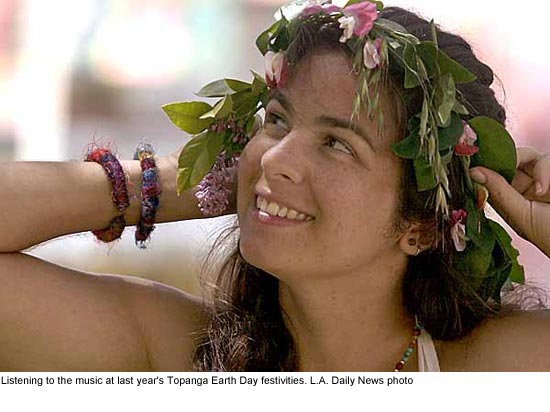
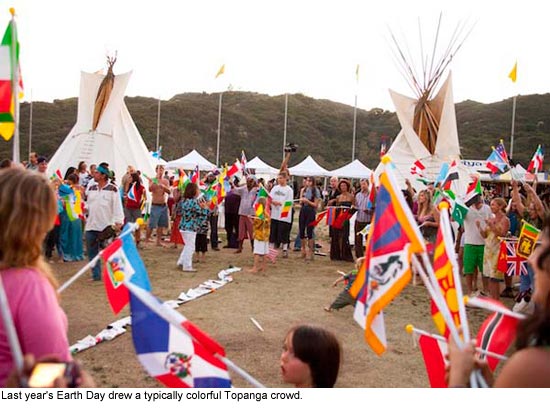
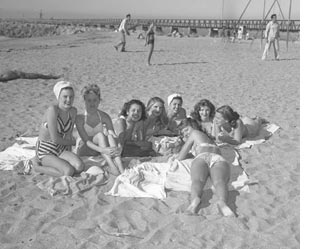

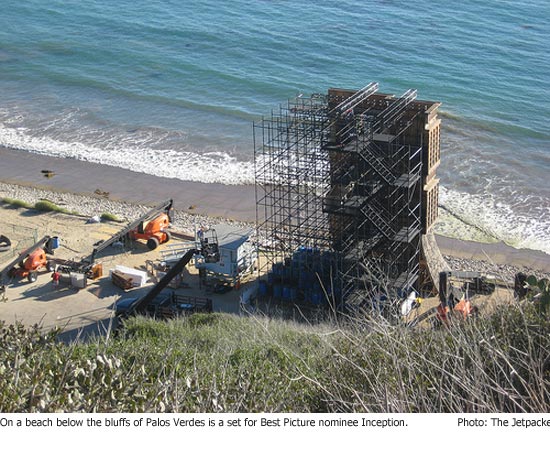
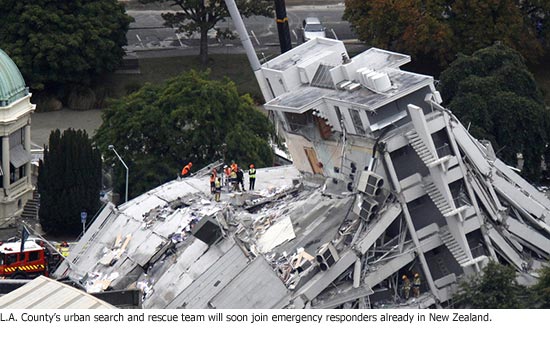







 405 bridge work causes a stink
405 bridge work causes a stink

